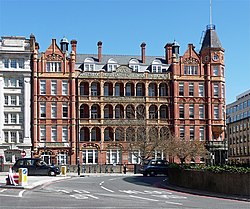|
Royal Waterloo Hospital for Children and Women
The Royal Waterloo Hospital for Children and Women was a hospital located on the corner of Waterloo Bridge Road and Stamford Street near Waterloo station in London, England. The current building was designed by noted ecclesiastical architect Sir Charles Nicholson at a cost of £45,000 and included an outpatients' department and inpatient accommodation of 90 beds. The hospital closed in 1981 and is now a dormitory building for the London branch of the University of Notre Dame. HistoryThe hospital was founded by Dr John Bunnell Davis in 1816 as the Universal Dispensary for Children.[1][2] In this first incarnation the hospital was located at St Andrew's Hill, in the now demolished Doctors' Commons in the City of London.[3] The name of the hospital was changed to the Royal Universal Dispensary for Children in 1821 and, after a foundation stone was laid by the Duke of York for new premises near Waterloo Bridge in 1823, it moved into the new premises in 1824.[2] It became the Royal Universal Infirmary for Children in 1824, the Royal Infirmary for Children in 1843 and the Royal Infirmary for Children and Women in 1852.[4] In an 1856 review of the hospital system in London, the British Journal of Homeopathy noted the serious shortage of hospital beds for children in London:
The hospital underwent a further name change to the Royal Hospital for Children and Women in 1875.[3] The new hospital was opened by Princess Louise in 1877, with one ward renamed the Louise Ward in her honour. [6] Between 1903 and 1905, to the designs of Sir Charles Nicholson,[4][7] the current premises was built at a cost of £45,000 to house an outpatients' department and inpatient accommodation of 90 beds at the corner of Waterloo Bridge Road and Stamford Street near Waterloo station.[8] By the year of the hospital's rebuilding in 1903 the concerns over bed space remained: an article in the British Medical Journal raised the concern that the Waterloo site left little room for extension.[9] It became the Royal Waterloo Hospital for Children and Women at that time.[2] The hospital joined the National Health Service in 1948 as part of the nearby St Thomas' Hospital group of hospitals (now Guy's and St Thomas' NHS Foundation Trust). The Royal Waterloo Hospital closed on 27 July 1976.[3] The building was awarded Grade II listed status by English Heritage on 15 May 1980.[4] It was sold the following year, and for the next three decades was the central London campus of Schiller International University. In 2011, Schiller International University moved out of the building and sold it to University of Notre Dame of South Bend, Indiana, USA where it was renovated and converted into dormitories.[10] Notable staff
See alsoReferences
External links
|
||||||||||||||||||||||||||||||||||
Portal di Ensiklopedia Dunia

